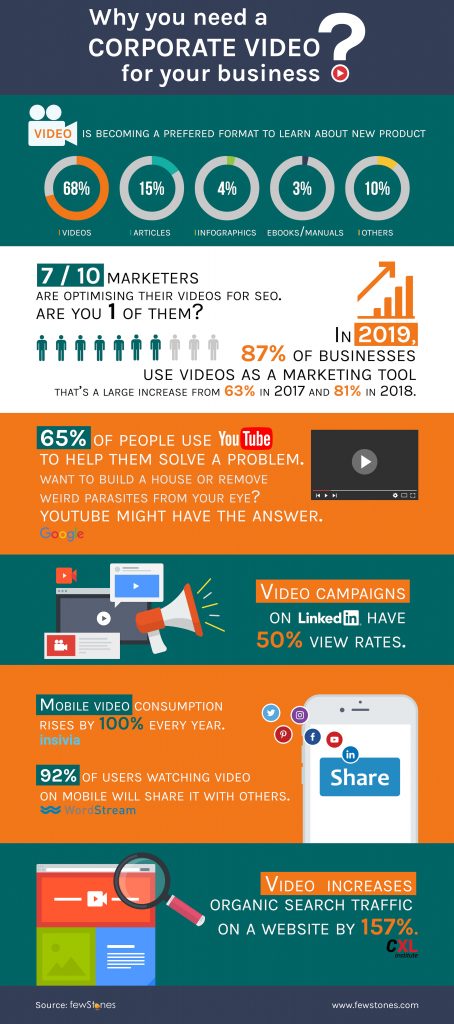Our Services
Check out our guide below
Over the years, we’ve seen the churn for corporate videos that are meant for marketing. Today, videos are used in the entire business flywheel, from internal to external corporate communications, investor pitches to product demos and more.
In this guide, learn how you can leverage your business using a goal-oriented strategy.
Navigate To
The goal of your corporate video
In the long run, sending through large chunks of informative text content will no longer cut it. 59% of executives would rather watch a video than read texts (WordStream), and marketers should consider creating videos to drive conversion.
Though, before we start thinking about what type of videos you’ll need, we should find out WHY your target audience will be likely to watch your videos.
The 2 main reasons why people are watching videos today are to solve a problem and to be entertained. I’m sure you watched a How-To video to fix a minor problem at home DIY-style, or have animal videos on replay just because it’s funny.
The only way to have an effective video (that you’ve invested much time and money in) is to drive an advantage to these viewers.
In the conceptualisation process, you should figure out who your target viewers should be, and how you can bring them useful information in a concise (or entertaining) manner. By nailing down your target audience, you can understand their goals.
If you use that to establish what’s important to them, you can effectively create a need for them to watch your video.
Ultimately, every video should have a goal. Finding the perfect call-to-action at the end of the video is important. Be it in a YouTube end card or a talent asking the viewer to take an action, it is key to ensure that this call-to-action is something relatable yet attractive for your audience.
Have you been saddled with the task of planning for an upcoming video campaign that your company plans to boost brand awareness with? Get in touch with us. We can help you.
Why do I need to hire a video production company?
You will have guaranteed quality with a team of experts who have a good portfolio and a process in place.
If you have a production background, you’ll understand that video production is not easy. Without a full team with the right equipment and expertise, it is hard to realise the vision you wanted of your video.
Even with highly experienced teams, video production is often a disorganised mess. Hire a company that knows how to make a video and handle the high demands of the job.
What does a video production studio do?
Typically, the company will help with all aspects ranging from conceptualisation to final delivery. They will help with creative planning, scripting, scheduling, casting, filming, post-editing, transcribing and more.
There are some that only films or provide post-production services (video editors in Singapore). fewStones can help with all aspect of video production, even after the delivery of the video, with video marketing on YouTube. Get in touch with us.
How to manage a video production agency?
It is important to know how to manage your video company lest it becomes a problem, and your video quality gets affected in the process.
Keep tabs on the progress but give some space to the team for creative flow. Share your vision early in the process and understand that communication is key. Be open to ideas, as a video production company would be able to give you sound advice given they have the ‘outside eye’.
Strong relationships build the best videos, and it’s been proven. If all goes well, you might even find a long-term partner for your next few video projects!
Different types of corporate videos
Understand your options when it comes to the different types of videos you can produce for a good marketing strategy. There are many types of corporate video production:
Brand videos
- Promote your business by visually embodying your brand’s vision and mission without overtly selling a specific product or service. Today, we understand that people do not buy products or services as much as they buy the company’s values. Having a video highlighting your ethos is a great way to stay ahead of the curve.
Product videos
- Are you planning to launch a new product or feature? For details that are too minute and specific, it is best to showcase and explain features in a concise product video where texts and images can’t. An excellent product video will do more than explain, but evoke feelings & relatability that converts the viewers into your customers.
Explainer videos
- Got a complex idea or product that you need to transform into easily digestible content? Use explainer videos to answer your prospects’ questions using short and easy animated videos. Get creative with dynamic graphics, footages of your product and references to your audience’s words.
Testimonial videos
- Your happy customers are a great source of marketing opportunity! People are increasingly more skeptical and it is difficult to build trust with a new product. Testimonial videos, when done correctly, can pull in prospects and show them how your product has successfully solved problems. Let these happy customers be your advocates and turn your potential customers into new ones. The more testimonial videos you have, the more trust you’re building.
E-Learning videos
According to Insivia, viewers retain 95% of a message when they watch it in a video, compared to 10% when reading it in text. That goes to show how effective a video can be for educational purposes.
It’s no wonder why HubSpot Academy and LinkedIn Learning, world leaders in free online training for marketing, sales and customer service professionals, use video formats to conduct their courses.
Event coverage videos
- Going to host a conference, exhibition, roundtable soon? Every event is special, and you don’t want to miss out on capturing certain details without an event videographer on site. Having an event video is a perfect way to establish and position your brand in the market. You can cover interviews of your clients, vendors & attendees and use this as social proof for your next event. Need marketing materials in the future? Easy, use the same content captured at this event for future campaigns.
Whiteboard videos
- A whiteboard video is a type of explainer video, and they are very popular for an obvious reason – we are used to learning from whiteboards in the business boardrooms or classrooms. The white space provides a distraction-free background, and it is easy to follow ideas that unravel in this video style. If your message is about a really complex idea, a whiteboard explainer video might be your ideal vehicle as such setup can boost viewers’ retention rate by 15%.
and many others…
The world’s average attention span is getting shorter (at just 8 seconds), and information is too saturated in today’s world. Using the many forms of videos, you can break through the ad-clutter and inspire action.
Animated VS Live Action video?
You’ve established that you’ll need a video now, but do you need an animated or live action video?
An animated video in the form of 2D or 3D animation (or motion graphics), takes the art of drawing sketches and placing them in a series of frames to make the images look like they’re moving.
A live action video, on the other hand, refers to cinematography or videography that records real-life objects or people. You’ll most likely be working with a videographer in Singapore or be filming the scene using a video camera. Here are our two cents on when you should use each type of video.
Ready to create your corporate video? Get a quote here.
Choose animated videos to simplify complex messaging
An animated video has the ability to simplify multifaceted concepts in a way that textual explanations can’t. If you need to demonstrate how your proprietary technology works, a corporate animated video could be the perfect choice.
Software services or data analytics tend to be dry and hard to understand, and a story-based structure will allow viewers to fully grasp the benefit of the operations.
Choose animated videos to create brand recall
The beauty of an animated video is that you are able to present your brand’s visual identity to the customers – with total control over the look & feel of your video. Details such as the character design, colours, timings, transitions and soundtrack can be building blocks of your branding.
Let’s say you know your target audience include pregnant mothers and the elderly, your animation video could have these characters created with the colours in your colour palette. This builds an opportunity for brand recall, and the resonation to the persona will make your audience feel inclined to finish watching your video.
Choose animated videos if you do not want to be limited by scripts (or reality)
With corporate animated videos, every tweaks or changes can be done in the studio, and there is hardly any limit to what you can animate. You can create objects that grow, people that fly and a background that changes from day to night in seconds.
There is no worrying about the hiring of talents, weather contingency plans or location recce, where every change could result in a re-shoot.
Choose live action videos if you have a tangible product
When you have a real product, you should create this video in live action. Take a watch, for example. Most of your customers would probably choose to film it in action rather than as an illustration, to look at the exact product they’re buying.
A product video like this will have a headstart, compared to animation, as you don’t have to build the digital assets from the ground up.
Choose live action videos if you sell on being personal
Let’s say you need a recruitment video for your company. To attract candidates, it’s better to show live action footage of the company’s people and their interactions on a day-to-day basis.
It’s proven – people like seeing other people and definitely helps build an emotional connection, which could be extremely helpful if relationship building is a key part of your business strategy.
Related article: Live Action Videos vs Animated Videos: What’s Best for Your Business?

Statistics for corporate video production in Singapore

- Video is becoming the preferred format to learn about a new product.
- 7 out of 10 marketers are optimising their videos for SEO
- In 2019, 87% of businesses use videos as a marketing tool. That’s a large increase from 63% in 2017 and 81% in 2018.
- 65% of people use YouTube to help them solve a problem. If you want to build a house or remove weird parasites from your eye, YouTube might have the answer. – Google
- Video campaigns on LinkedIn have 50% view rates.
- Mobile video consumption rises by 100% every year. – Invisia
- 92% of users watching video on mobile will share it with others. – WordStream
- Video increases organic search traffic on a website by 157%. – CXL Institute
Best scriptwriting practices for your corporate video

Some corporate video production agencies in Singapore may ask if you’ll have a script handy before production begins, and you wonder if you should be creating one yourself, or be leaving it to the pros. If you’re a creative who is always churning content, whether as a marketer, journalist or even a personal blogger, then you should no qualms writing a script. It should be no different than what you’re usually doing – you tell a story, with the aim of captivating your audience. Here’s how to write a production-ready script for your video agency in Singapore.
- Write a brief for your corporate video
Building a strategic overall brief will help you further down in the steps of writing a good script. Use this brief to iron out the direction of your corporate video, such as determining your purpose, call-to-action and the audience of the video.
- Translate the brief to a simple story
Here’s where you get creative! Use your imagination to create a simple story. Take on the audience’s persona and find out the different buzzwords that they use. With a story, you can gather a logical progression of an outline and be on your way to a well-scripted video.
- Draft your script using a 2-column template, using more than just words
Once you’ve written a brief, use that as your guide to piece together audio & visual components section by section. It serves as a corporate video guide so that you’ll not be losing any important scenes and voiceovers before you end production.
- Read your script aloud
Do a verbal run-off with the 1st draft of your script. Some words look good when written, but they may not necessarily roll off the tongue.
- Edit, edit and re-edit and proofread your script against your brief
Fine-tune your script to remove words that are too informal, too formal, too robotic, etc. Remember to refer to your initial brief to make sure you’re on board with your vision!
A corporate video can only be as good as your script and we all know that good corporate video production lies in the scriptwriting. You’re going to need a script for corporate video production. A script helps you build the backbone of your video, develop the step-by-step process to get your imagination transformed into visual & audio deliverables.
Creating a Story That Sells – How to Make a Great Corporate Video Storyboard
The name alone helps explain what it is – a visual representation, either with computer-generated or hand-drawn images of what is going to happen or appear on screen in each scene of your video.
On the inside of each board, there will be pictures, and beneath the box, some notes relevant to that scene.
How to Create a Great Storyboard
To help you create a great storyboard, we are going to outline the various steps you can take. Although it may seem like extra work on top of your already busy schedule, having the details of your video all laid out on a screen or paper can be hugely beneficial.
- Find a suitable storyboard template
It sounds easy enough to create a storyboard. If you’re not the best at drawing though or don’t want to worry about measuring out boxes, don’t fret. There are various resources online where you can find basic storyboard templates for free.
- Fill in the storyboard
The next step you need to take when creating a potent corporate video storyboard is to fill in the template with all the details of each scene. Remember, you don’t need to be detailed with the sketches or graphics in each square, you just need to show a clear progression from one to the next, so there’s a story running from the start to the finish.
What you include will also depend on how you’re making your video. If it’s going to include physical shoots with real actors and real-world locations etc. you need to make notes of the locations and the people in each scene, along with details like music, narrations, dialogue, the framing, angles, and camera movement.
If it’s an animated video, notes are still needed to explain what is happening and how you want it to be presented. You also need to figure out the timeframe, not just for the full video, but each individual scene. This will also help ensure the most important scenes last the longest and that the flow is right from the beginning through to the main content and to the call-to-action.
Best Tips For Your Corporate Video
Focus on your objectives and goals
The best corporate videos have focused messages because top companies take a lot of time to make sure they plan out all of their objectives and goals in detail even before the start of production.
When you have clear objectives and goals for your corporate video, you will have an easier time shooting for it and editing it because you already have a strong idea of what it should achieve.
Highlight the benefits for your customers
Every company wants to make sure that their corporate video will resonate deeply with customers. The best way for you to do that is by highlighting the most important benefits for them.
Just naming all of your features won’t be memorable to viewers, you will need to show how these features actually make their lives easier in the corporate video.
Combine your video’s information with eye-catching visuals
The design of your corporate video should be aligned with your brand personality and consistent with the information and content you are delivering in it.
When designing what your visuals will look like, think of colors and images that can help bring your ideas to life. Whatever style you decide to do, whether it’s more professional or more casual, make sure it is consistent with all of your other content.
Do not forget to include a call to action
Great corporate videos do not just end abruptly. After showing how your brand can positively impact the lives of your customers, you should urge them to perform an action to continue your relationship.
Including a call to action is important because it allows you to direct viewers to perform any preferred action that will lead them to conversion. This gives them an opportunity to connect with your brand even after watching your corporate video.
Upload your video to the right platforms
Finally, one last important thing to remember for your corporate video is planning out which platforms you will choose to upload to.
While you can have a lot of different options like YouTube, Facebook, Instagram, or Vimeo, you should always look back at the goals you have set at the start to finalise what platforms you will use.
As long as you follow these tips, you will be assured of a great corporate video for your company in Singapor


